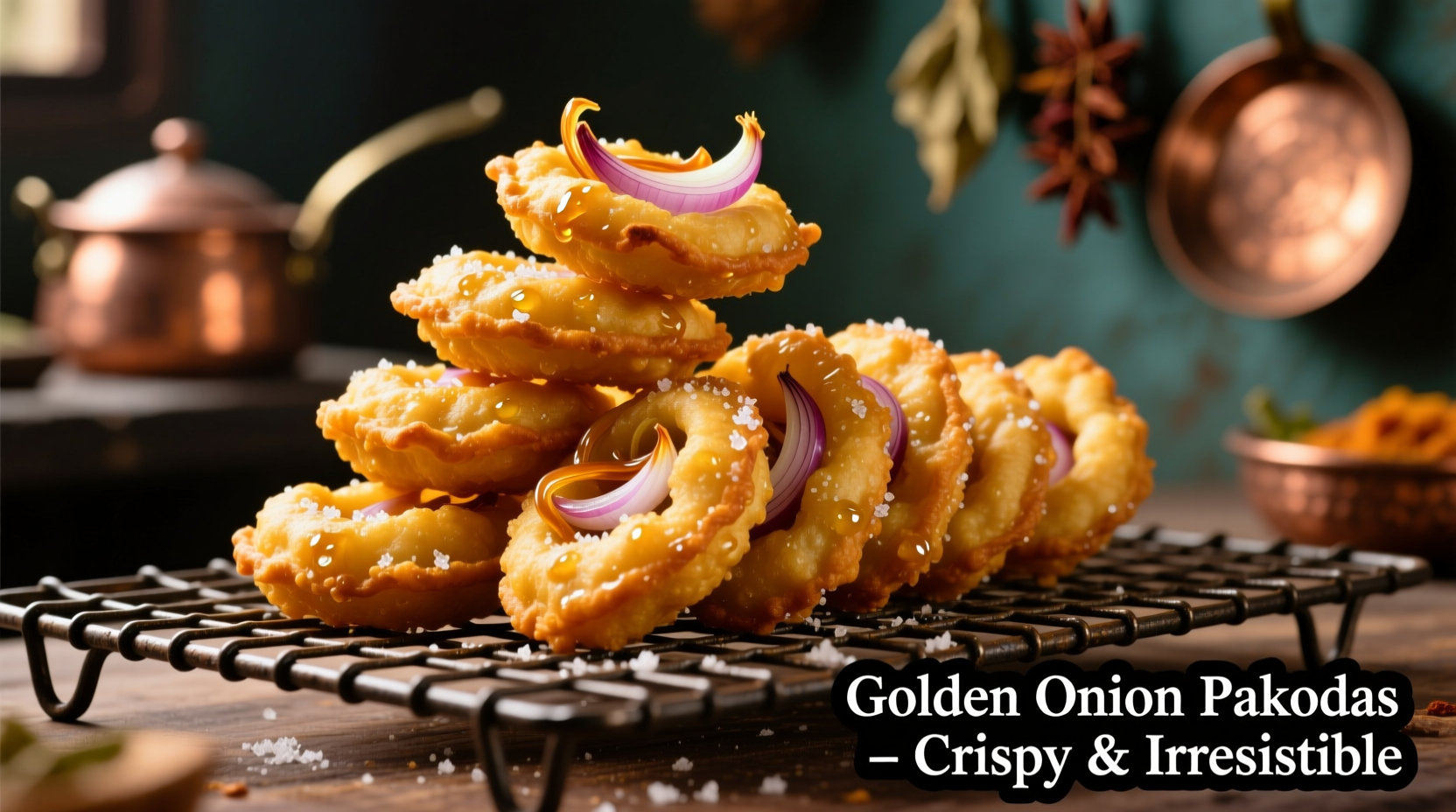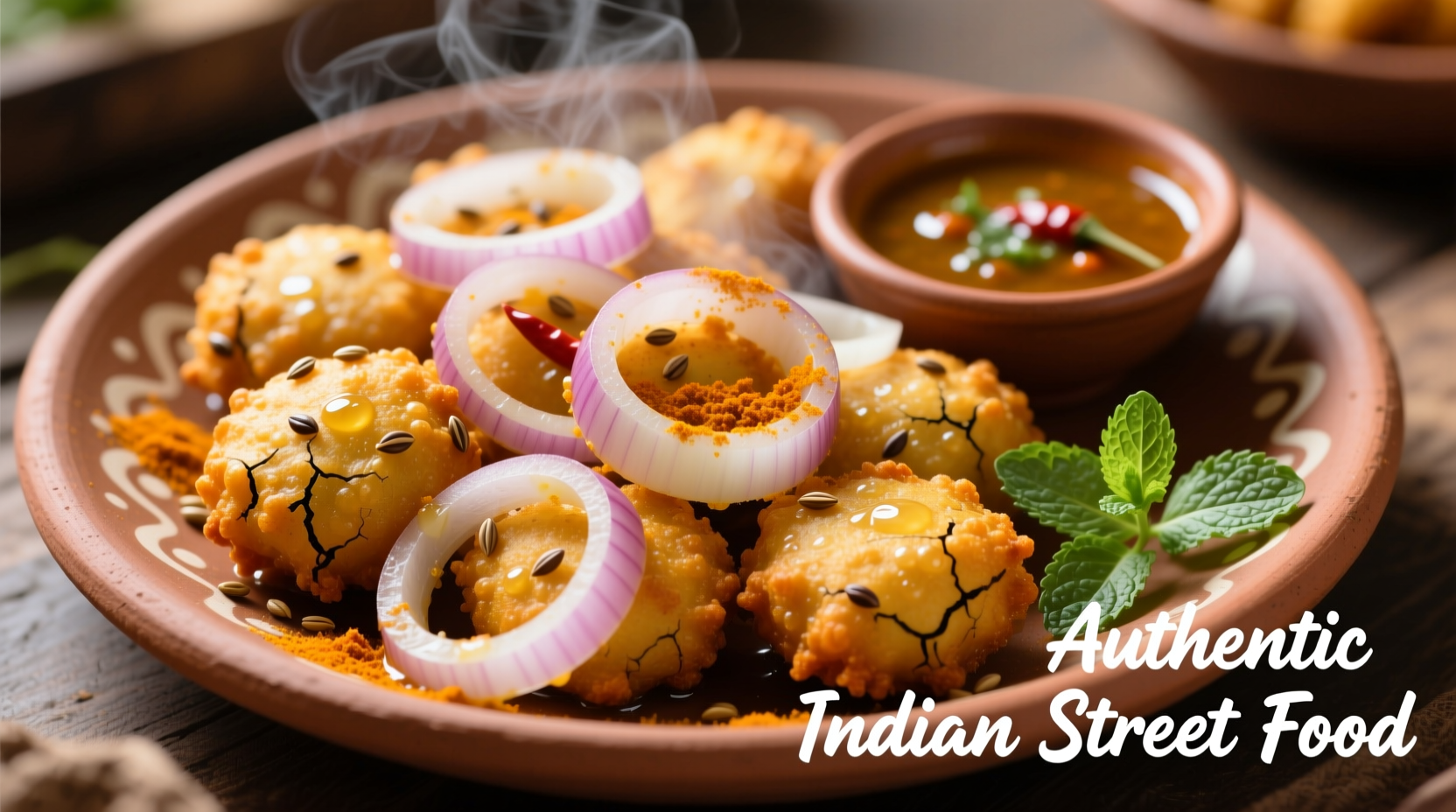Get perfectly crispy onion pakodas every time with this authentic recipe featuring the ideal batter ratio, optimal oil temperature (350-375°F), and professional frying techniques that prevent sogginess. This traditional Indian snack requires just 7 pantry staples and 20 minutes to prepare.
There's nothing quite like the satisfying crunch of freshly made onion pakodas—the quintessential Indian tea-time snack that transforms humble ingredients into golden perfection. As a culinary tradition spanning centuries across the Indian subcontinent, these spiced onion fritters have evolved from street food staple to global comfort food favorite. Whether you're craving that perfect tea companion or exploring authentic Indian cooking techniques, mastering onion pakodas opens the door to understanding fundamental Indian frying principles that apply to countless other snacks.
The Science Behind Crispy Onion Pakodas
Achieving that signature crunch while maintaining tender onion centers isn't magic—it's food science. Professional chefs know that successful pakodas depend on three critical factors: batter hydration level, oil temperature control, and proper onion preparation. When gram flour (besan) meets water at the right ratio, it creates a gluten-free batter that fries up light and crisp without absorbing excess oil. The ideal batter consistency should coat the back of a spoon but drip off slowly—too thin and your pakodas will be greasy, too thick and they'll be doughy.
| Regional Variation | Key Ingredients | Distinctive Technique |
|---|---|---|
| North Indian | Carom seeds, ginger | Double-frying for extra crispness |
| South Indian | Curry leaves, mustard seeds | Thinner batter, single fry |
| Gujarati | Jaggery, turmeric | Onion marinated in spices first |
Authentic Onion Pakoda Recipe
This perfected recipe delivers consistently crispy results by balancing traditional techniques with modern kitchen precision. The secret lies in the batter hydration and oil temperature control—critical factors often overlooked in simplified recipes.
Ingredients for Perfect Onion Pakodas
- 2 large red onions (about 500g), thinly sliced
- 1 cup (120g) gram flour (besan), sifted
- 2 tablespoons rice flour (for extra crispness)
- 1 teaspoon carom seeds (ajwain)
- 1 teaspoon red chili powder
- ½ teaspoon turmeric powder
- ½ teaspoon baking soda (only for first-time cooks)
- Salt to taste (about 1 teaspoon)
- 3-4 tablespoons ice-cold water
- Fresh cilantro, chopped (optional)
- Neutral oil for frying (must have high smoke point)

Step-by-Step Preparation
- Prepare onions: Slice onions thinly (1/8 inch) and separate into rings. Pat completely dry with paper towels—moisture is the enemy of crisp pakodas.
- Mix dry ingredients: In a bowl, combine sifted gram flour, rice flour, carom seeds, chili powder, turmeric, baking soda, and salt.
- Create perfect batter: Gradually add ice-cold water while whisking until you achieve a thick but pourable consistency (like pancake batter). The batter should coat the back of a spoon but drip off slowly.
- Combine with onions: Gently fold in onions and cilantro just before frying—overmixing releases onion moisture that thins the batter.
- Heat oil properly: Fill a heavy-bottomed pan with 2 inches of oil. Heat to 350-375°F (175-190°C)—use a thermometer for accuracy. Test with a small batter drop; it should sizzle immediately and rise to the surface.
- Fry in batches: Drop spoonfuls of batter into hot oil, maintaining space between pieces. Fry 3-4 minutes until golden brown, flipping once. Don't overcrowd the pan.
- Drain properly: Transfer to a wire rack (not paper towels) to maintain crispness. Sprinkle with additional salt while hot.
Pro Tips for Restaurant-Quality Results
Based on professional kitchen experience, these techniques transform good pakodas into exceptional ones:
- Temperature control: Maintain oil between 350-375°F throughout frying. Below 350°F causes oil absorption; above 375°F burns the exterior before onions cook through.
- Dry onions thoroughly: Even small amounts of moisture create steam pockets that make pakodas soggy. Let sliced onions sit in a colander for 10 minutes to release excess liquid.
- Use ice-cold water: Cold liquid slows gluten development in the batter, creating a lighter texture. Never use room temperature water.
- Double-fry technique: For extra-crispy results, fry once at 325°F to cook through, then again at 375°F for 30 seconds to crisp up.
- Season while hot: Salt adheres better to freshly fried pakodas. Wait until they're drained but still warm.
Regional Variations Worth Trying
India's diverse culinary landscape offers fascinating regional twists on this classic snack:
- Gujarati Onion Kachori: Incorporates a pinch of jaggery into the batter for subtle sweetness that balances the savory spices.
- South Indian Onion Bajji: Features curry leaves and mustard seeds in the batter, often served with coconut chutney.
- Punjabi Onion Pakora: Uses a thicker batter with added ginger and green chilies for robust flavor.
- Hyderabadi Onion Pakoda: Includes a touch of garam masala and fried until extra crispy for Nizami-style tea pairing.
Serving and Storage Guidelines
Onion pakodas are best enjoyed immediately while piping hot and maximally crisp. Serve with:
- Classic mint-coriander chutney
- Tamarind-date chutney
- Freshly brewed masala chai
- Plain yogurt with roasted cumin powder
For storage, keep in an airtight container at room temperature for up to 24 hours. To revive crispness, reheat in an air fryer at 350°F for 3-4 minutes. Avoid microwaving, which creates sogginess. Never refrigerate pakodas—moisture from condensation destroys crispness.
Common Mistakes to Avoid
Even experienced cooks make these critical errors that compromise pakoda quality:
- Using wet onions: Always dry onions thoroughly before mixing with batter
- Incorrect oil temperature: Invest in a kitchen thermometer for consistent results
- Overmixing batter: Mix just until combined to prevent tough pakodas
- Crowding the pan: Fry in small batches to maintain oil temperature
- Using old gram flour: Besan loses potency after 3-4 months; check freshness date
Frequently Asked Questions
Can I make onion pakodas without gram flour?
While gram flour (besan) is essential for authentic texture and flavor, you can substitute with chickpea flour or a blend of ¾ cup all-purpose flour and ¼ cup cornstarch. However, the distinctive nutty flavor and crispness of traditional pakodas won't be replicated. For gluten-free options, rice flour alone works but produces a more delicate texture.
Why do my onion pakodas turn out soggy?
Sogginess typically results from three issues: onions not dried properly (releasing moisture during frying), oil temperature too low (below 350°F), or batter too thin. Always pat onions completely dry, maintain proper oil temperature with a thermometer, and adjust batter consistency with additional gram flour if needed. Frying in batches prevents temperature drops that cause oil absorption.
How can I make onion pakodas healthier?
For a lighter version, use an air fryer at 375°F with a light oil spray (8-10 minutes, flipping halfway). Reduce oil absorption by ensuring onions are thoroughly dry and maintaining proper oil temperature. You can also add 2 tablespoons of psyllium husk to the batter for extra fiber. Remember that traditional pakodas are meant as occasional treats—their appeal lies in the perfect crisp-to-soft ratio achieved through proper frying.
What's the best oil for frying onion pakodas?
Choose oils with high smoke points (above 400°F) and neutral flavors: peanut oil, sunflower oil, or safflower oil work best. Mustard oil provides authentic North Indian flavor but requires preheating to remove raw pungency. Avoid olive oil (low smoke point) and coconut oil (strong flavor that competes with spices). Always use fresh oil—reused oil develops off-flavors and lowers smoke point.











 浙公网安备
33010002000092号
浙公网安备
33010002000092号 浙B2-20120091-4
浙B2-20120091-4